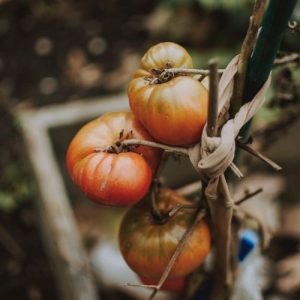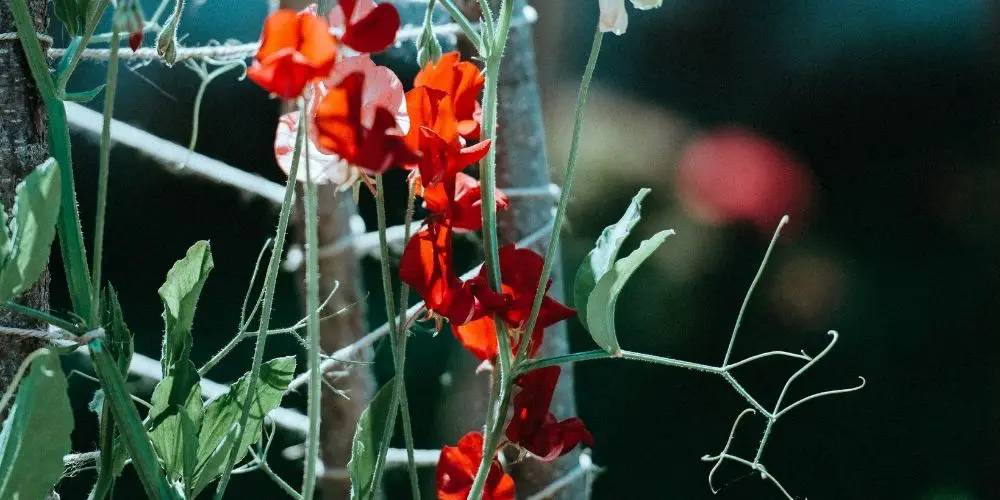There are many plants that are easy to care for after the initial planting stage as most herbs tend to grow fairly short and simple with foliage. Herbs and flowers are easy to tend to during their growing season, but there are some fruit and vegetables that require maintenance to ensure they’re successful.
Some plants are delicate, growing in vines that rapidly produce fruit and may aid from the help of a cage or trellis such as peas or squash.
Tomato plants are usually sturdy annuals that may naturally grow like any other upright nightshade, but in recent years of modifying these plants for bigger, juicier tomatoes we’ve found they struggle with supporting hefty crops. Their stems are not strong enough to bear many heavy tomatoes, leading to your plant’s breakage, loss of crop, and puts your plants at risk to pest and disease. However, if given the proper support and care, your tomato plants can carry a great deal of fruit without any breakage. In this article, we are going to go over a few different ways on how to give your tomatoes the support they need.
Why do tomato plants need support?
Tomatoes occur naturally and it is completely possible for them to grow on their own. With human interference, these plants have been bred to the point where they can produce heftier tomatoes with ease but may still lack enough stem strength to support this new weight.
Instead of growing upright, the fruit may drag down or break the plant’s supporting stems hindering their growth. The term for when tomatoes are left to grow naturally without any form of support such as cages or trellises, is called crawling. Tomato plants that are left to crawl and spread across the ground are at a closer contact point with the soil. Exposed leaves and stems making ground contact are more prone to soil-borne diseases.
If the ground is excessively wet, this could lead to a higher chance of mildew and rot to your plant’s stems, leaves, and fruit. Crawling tomatoes are also at risk for pests, both insects and mammals, as they are left unprotected on the ground.
1. Using Cages To Support Your Tomato Plants
A good cage to support a large tomato plant should be about 5 feet tall and 25 – 30 inches in diameter, as this should be plenty enough to space for a tomatoes to thrive. Make sure the cage is made of a sturdy material such as concrete reinforcing wire rather than biodegradable sticks for this helps brace your plants for windy or undesirable weather conditions.
There should be enough space in the grids for you to reach in a hand to pull out your fruit, or else it could be a tedious task untangling the plant from the cage in order to harvest. Apply a cage to a seedling rather than a maturing plant so you don’t damage it during the process.
This should help your plants maintain and provide foliage over growing tomato fruits that will prevent sun scalding. It is important to give your cages about 1 – 2 feet of space, giving them ample amount of space to establish roots and room for the cages to fall in case of bad weather.
There is also a trick that may prevent hornworms from young, vulnerable plants. In spring, wrapping the cages in saran wrap or plastic may encourage your seedlings to growing by providing more heat, wind protection and could deter pests!
2. Using Trellises To Support Your Tomato Plants
If you would prefer to use a different method to prevent your tomatoes from crawling, there is also trellises! Trellises are a bit simpler than cages, as they can be placed alongside a fence, It is simple to weave young tomato seedlings as they grow through trellis fencing while it provides consistent and sturdy support. This allows for more tomato plants to be planted close together in one space.
The trellises should be about the same height as mentioned for cages, but can also be higher in price range. This method is great because you can greatly reduce the risk of nutritional deficiencies and diseases, while also providing an ample amount of foliage and shade for your tomato fruits.
You won’t have the struggle of untangling your tomatoes from cages or reaching your hand through small grids to retrieve your hard earned harvest. The cons with working with trellis could be the start-up or building of the trellis, for it can be quite laborious and costly.
3. Using Stakes To Support Your Tomato Plants

This is another method that takes up less space than caging and also less hassle than trellises. Stakes may provide your tomato plants with the support they need to produce giant fruits that you can easily access. This method is an easy installation and can be found in many local garden centers located near the tomato cages.
Like with trellises, you must also train your tomato plant to grow up along the stakes to prevent them from crawling. While tying and pruning the stems may seem like a tedious task, this method can be the best for accessing your plant’s crop once they come to fruition.
Due to the pruning, this will lead to larger tomatoes and earlier fruit due to the energy being directed towards fruiting instead of stems or foliage. Even though the fruit may be larger, the overall crop yield may be reduced due to the excessive pruning that takes place while using the stake method.
Conclusion
Any way that you decide to support your tomatoes is completely preferential and depends on your gardening style. All methods require minimal amount of care and attention in order to prevent accidental crawling.
Staking and cages are a cheaper, simpler method than building a trellis but they may also be weaker protection from unforgiving weather.
All of these methods are better for a bigger crop yield rather than letting your tomato plants grow naturally without extra support, so any of these options should be a solution for a droopy tomato plant. Happy planting!

![How you can easily support your Tomato Plants [Cages, stakes, trellis]](https://brilliantgardener.com/wp-content/uploads/2021/03/Tomato-Plant-with-Cage.jpg)













